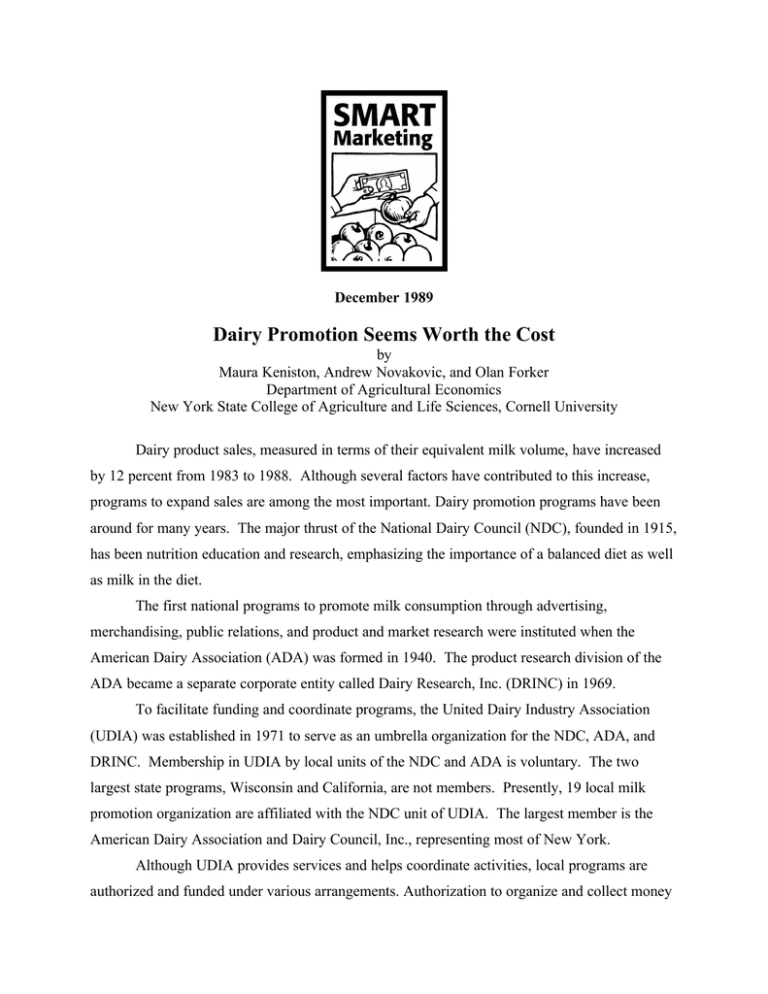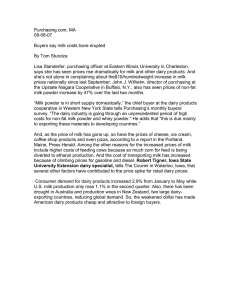Dairy Promotion Seems Worth the Cost
advertisement

December 1989 Dairy Promotion Seems Worth the Cost by Maura Keniston, Andrew Novakovic, and Olan Forker Department of Agricultural Economics New York State College of Agriculture and Life Sciences, Cornell University Dairy product sales, measured in terms of their equivalent milk volume, have increased by 12 percent from 1983 to 1988. Although several factors have contributed to this increase, programs to expand sales are among the most important. Dairy promotion programs have been around for many years. The major thrust of the National Dairy Council (NDC), founded in 1915, has been nutrition education and research, emphasizing the importance of a balanced diet as well as milk in the diet. The first national programs to promote milk consumption through advertising, merchandising, public relations, and product and market research were instituted when the American Dairy Association (ADA) was formed in 1940. The product research division of the ADA became a separate corporate entity called Dairy Research, Inc. (DRINC) in 1969. To facilitate funding and coordinate programs, the United Dairy Industry Association (UDIA) was established in 1971 to serve as an umbrella organization for the NDC, ADA, and DRINC. Membership in UDIA by local units of the NDC and ADA is voluntary. The two largest state programs, Wisconsin and California, are not members. Presently, 19 local milk promotion organization are affiliated with the NDC unit of UDIA. The largest member is the American Dairy Association and Dairy Council, Inc., representing most of New York. Although UDIA provides services and helps coordinate activities, local programs are authorized and funded under various arrangements. Authorization to organize and collect money from farmers has come through voluntary plans of dairy cooperatives and state legislation. It was not until the Dairy Production and Stabilization Act of 1983, through the establishment of the National Dairy Promotion and Research Board (NDB), that a national dairy product promotion program was funded by all dairy farmers in the lower 48 states. The Dairy Product and Stabilization Act requires that 15 cents/cwt. Be assessed on all milk marketed in the 48 contiguous United States. The assessment, which generates over $200 million per year, goes to generic milk promotion agencies. At least 5 cents must be forwarded to the NDB by the first handler of a farmer's milk. Up to 10 cents of the assessment can be directed to a local, qualified milk promotion organization. Currently, about 5.5 cents, on average, goes to the NDB. New York is one of several states that have had marketing orders or legislation authorizing assessments on milk produced in their states. In New York the 10-cent portion is forwarded to the New York State Department of Agriculture and Markets. The money held by the department is spent according to the direction of the New York Milk Promotion Advisory Board. Is milk promotion effective? A recent USDA report suggests that "advertising may also have bolstered per capita consumption of some dairy products, especially fluid milk and cheese. But the effect appears to have been small when compared with price and income effects." The issue is not whether price or income effects are greater than advertising effects, but whether advertising generates more income than it costs. Research indicates that promotion can result in higher sales. In some cases (fluid milk in particular), returns to farmers have been shown to be higher than costs. In other cases, the results have been inconclusive or negative. In general, research has not proven for all time that promotion is cost effective; however, the results are mostly encouraging. Why don't we have more evidence? It has been difficult to collect data for sophisticated statistical analyses that accurately measure the dollar value and quality of all promotion programs, especially in a way that can be matched up to dairy product sales data. Cornell research and New York experiences suggest that generic promotion is worth continuing. Ongoing research, with periodic review, can continue to improve the management of farmers' funds for promotion purposes. This article is an abbreviated version of a leaflet in the series entitled "Dairy Policy Issues and Options for the 1990 Farm Bill."




